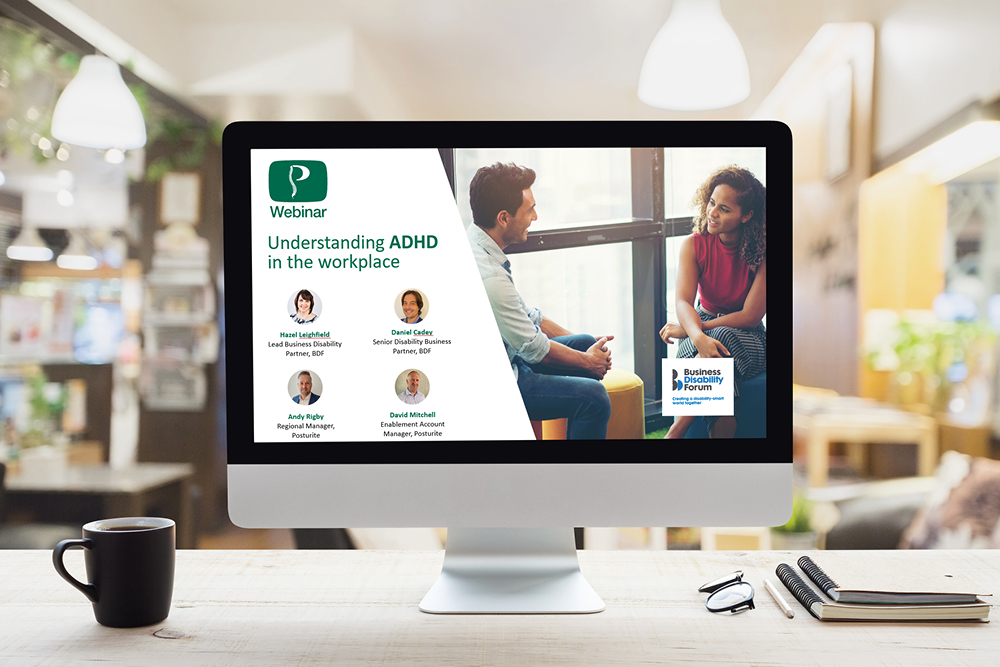
According to ADHD UK, there are an estimated 2.6 million people living with Attention Deficit Hyperactivity Disorder (ADHD). At least 3% of UK adults are thought to have ADHD but as it remains largely underdiagnosed, the reality is this figure could be higher.
Greater awareness is desperately needed for faster diagnoses for those that seek it and better inclusion of adults with ADHD in the workplace. People with ADHD are sometimes failed by ‘normal’ work environments where barriers exist, and reasonable adjustments are not always identified and implemented. In a Posturite webinar entitled Understanding ADHD in the workplace, Andy Rigby, Enablement Manager at Posturite, said:
“ADHD is common. It can be complex for some people, and it can have a real impact in the workplace. Both positive impact and potentially a challenging impact if the individual is either unaware or left without some assistance if they need it. So, creating this conversation, and creating this awareness for an increasing number of people is really exciting.”
With a little more education and understanding, barriers in the workplace can be identified and rectified, creating a more positive work environment for all.
What is ADHD?
ADHD is a lifelong condition that is present from birth. It’s a neurological spectrum condition that affects attention, impulses, and concentration, but can present in different ways in different people. Often left undiagnosed, ADHD falls under the umbrella of neurodiversity and is a non-visible disability. To identify traits of ADHD in ourselves and others therefore, there needs to be more education among all adults in the workplace.
Is ADHD considered a disability?
Yes, under the Equality Act 2010, an employee with ADHD may be considered to have a disability if the condition has a ‘substantial’ and ‘long term’ negative effect on their ability to carry out normal day-to-day activities. Employees have a right for ‘reasonable adjustments’ to be implemented to make their working environment safe and productive.
Reasonable adjustments for ADHD in the workplace
So, what are some of the reasonable adjustments that employers can make to remove barriers?
- Provide a quiet space to work or access to noise-cancelling headphones or white-noise headphones
- Offer more frequent, shorter breaks
- Organise work around medication if applicable
- Allow extra time for meeting or presentation preparation
- Enable note-taking or record meetings
- Offer support in planning tasks
- Give support in breaking long assignments up into shorter tasks
- Assistance with detailed paperwork
Many businesses unknowingly encompass barriers to inclusion, preventing employees from reaching their full potential. Enablement allows the creation of an equal workplace for everyone.
What to look out for: some common traits of ADHD
Daniel Cadey from the Business Disability Forum describes in Posturite’s ADHD webinar some of the ways ADHD might appear in the workplace, including difficulty organising workload, time management challenges, procrastination, impulsivity in conversation, e.g., interrupting or speaking out of turn, and being a little slower at making decisions. Somebody with ADHD might find it more challenging to prioritise tasks, struggle with short-term memory, be easily distracted, have weaker concentration, and have some hyperactivity.
But ADHD impacts individuals differently and the barriers encountered will vary.
How to support employees with ADHD

However difficult it is to broach this subject matter in the workplace, whether you are an employee, or an employer wanting to create a barrier-free workplace for a team member, doing something is better than doing nothing.
It can be frightening to think you might say or do the wrong thing, and of course it’s a matter that should be approached sensitively. But if someone is being prevented from doing a good job because their work environment has been designed around a perceived idea of what is ‘normal’, it does need to be addressed.
Hazel Leighfield, Lead Business Disability Partner at the Business Disability Forum, expands on what organisations can do to help people with ADHD in the Posturite ‘ADHD in the workplace’ webinar: “Both from leadership, but also with hiring managers and colleagues, it's about everybody being able to have that shift in culture as to how we support colleagues that are perhaps facing barriers. So, it's upskilling. It’s raising awareness of a neuro difference, basically a non-visible disability. And it's also having really good robust policies and practices in place, because you have to have good guidance.”
Businesses can employ third parties to help ensure they get it right and offer an inclusive environment to all employees. The Posturite Enablement Team, for example, help to boost staff productivity and fulfil their duties under the Equality Act.
Reduce stigma with greater awareness
Awareness training is a good first step to understanding ADHD at work. Training will help employees with ADHD to identify traits in themselves, to seek support, and give employers and other employees a greater understanding of the condition and some of its associated barriers. If everyone understands that there is a reason for certain behaviours in the workplace, they’re far more likely to be supportive.
Workplace needs assessments
If someone would like to understand if the barriers they are facing could be due to having ADHD, then an ADHD screening session followed by a neurodiverse workplace needs assessment can be undertaken.
These Posturite assessments identify whether an individual is experiencing traits associated with ADHD and what can be done to support. They can also identify circumstances in which a referral to a GP is necessary to allow access to medication. This isn’t always the case but can be helpful.
Workplace assessments also offer solutions.
- What ergonomic changes can be made to the individual’s workstation? For example, a Posturite team member with ADHD finds a sit-stand desk incredibly useful at work.
- What assistive technology can be used to help with work processes?
- And what kind of coaching might be needed to ensure maximum benefit from the new environment?
One-to-one workplace strategy training is also available to assist with ongoing stratagems for support.
Long-term support for colleagues with ADHD
 Once an assessment has been completed, areas for adjustment identified, and any resulting changes implemented to support employees with ADHD, it’s not time to put your feet up and forget all about it.
Once an assessment has been completed, areas for adjustment identified, and any resulting changes implemented to support employees with ADHD, it’s not time to put your feet up and forget all about it.
When questioned about how often adjustments should be reviewed in the Posturite ADHD in the workplace webinar, Daniel Cadey from the Business Disability Forum explains: “It does depend a little bit on what the adjustment is, but it’s about making sure that you recognise that once the adjustment has been put in place, that is a reset. That’s the beginning again. So, they shouldn’t immediately slip into ‘that’s it, this individual is now totally helped’, it should be, ‘now we need to judge whether this adjustment is working?’”
Even if the adjustment is offering the employee the changes they need, it’s still worth instigating regular reviews to make sure there is continued support. If it’s not working, the solution could be tweaked and reviewed again.
Unlock the potential: possible strengths of team members with ADHD
Recognise the strengths that employees with ADHD often bring to the table, as highlighted by The ADHD Foundation, and in turn their worth to the business:
- Skilful at coming up with creative ideas that might require thinking ‘outside the box’
- Lots of energy
- Often optimistic
- Spurred on by short term deadlines or goals
- Often scrupulous with a good eye for detail
- Ability to focus carefully on aspects of the job that interest them
- Willingness to take risks
- More willing to be flexible and spontaneous
- Effective in a crisis
ADHD in the workplace: a summary
If there is a lack of awareness about ADHD in the workplace in the UK, it can lead to discrimination. To prevent this, it seems sensible for there to be more education offering a means of supporting individuals who are facing barriers.
Workplace needs assessments for ADHD are invaluable in helping to identify barriers which are preventing good performance at work. Remember that adjustments could be relatively easy to make but have far-reaching benefits. It’s the responsibility of the employer and the employee to raise concerns about performance issues that could be related to ADHD, so that the situation can be improved. When done well, organisations can support employees with ADHD to showcase themselves at their best.
Read next:












